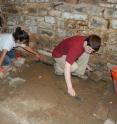Forgotten Annapolis immigration conflict uncovered by UMD archaeology
University of Maryland archaeologists are uncovering a forgotten period of racial tension in Annapolis pitting Filipino immigrants against African Americans. The surprisingly complex relations between the groups go back a century, occasionally marked by violence, but also by considerable social mixing and even intermarriage, the researchers say -- all propelled by changing racial practices at the Naval Academy.
"We're discovering family stories carved in irony," says University of Maryland Archaeologist Mark Leone, who is directing the research. "The home we're excavating belonged to an African American woman married to a Filipino man, anchored in Annapolis by the Naval Academy, brought together by its racial stereotyping, and yet overcoming cultural and racial barriers quite successfully in their own lives."
This is not an isolated incident, and descendants of those families continue to thrive today in a loose, extended network along the East Coast of the United States. "More than a dozen families managed to do this," Leone adds. "It's an episode of racial coexistence in Annapolis we're just uncovering and beginning to understand."
Leone's Archaeology in Annapolis Summer Field School has resumed digging for a third year at the East Street home of James Holliday, a freed slave and one of the first African Americans employed by the Naval Academy.
Holliday managed a middle class existence before the Civil War, serving as a courier for the Academy's Superintendent.
The house has remained in the family's hands since 1850. Holliday's granddaughter lived there when she married a Filipino cook serving at the Academy, Cosme Portilla.
Center of Philippine Settlement
In the early 20th century, a wave of Filipino immigration followed the Philippine-American War of independence. Opportunities at the Naval Academy made Annapolis an East Coast haven of opportunity for these immigrants, says Leone's graduate student Kathrina Aben, who has collected oral histories and documents as part of the research.
"The Academy hired Filipinos to work in the kitchen as messmen, officer stewards or laborers," Aben explains. "In practice, this meant replacing African Americans in their jobs."
In 1919, the year Holliday's granddaughter got married, the Academy's Commandant of Midshipmen Wat Tyler Cluverius, Jr. expressed a clear preference for Filipinos over African Americans. Filipinos, he said, were "clean, honest, military, studious, amenable to discipline," and "cost less to feed."
The policy had profound implications. "Over the years, it created economic competition between the two groups that occasionally led to racial confrontations and violence," explains Kathryn Deeley, one of Leone's Ph.D. students who is analyzing the archaeological finds at the Holliday House and related sites.
Deeley points to a February 7, 1931 story in Baltimore's Afro- American newspaper reporting a "new kind of race war." It tells of simmering feuds at the Naval Academy, and says that a riot almost broke out when a Filipino enlisted man knocked an African American kitchen worker unconscious.
"The racial realities of the time thrust these minority groups together, even while pushing them apart," explains Leone. "Both Filipinos and African Americans were legally prohibited from marrying whites then, and their economic horizons were limited. They lived near each other, socialized and intermarried, though community relations frayed at times."
Intermarriage and Cultural Blending
By the 1930s, at least 200 Filipinos lived in Annapolis, Aben reports. They were mainly single men, and a number of them got married after they arrived. She has identified at least 18 intermarriages with African Americans or women from other ethnic backgrounds.
"These Filipino men created new lives for themselves," Aben explains. "There were few Filipina women available and the immigrant men were quite adept at social adaptation and cultural blending. We're working to understand how these immigrants ultimately thrived to become the second largest group of Asian Americans."
Over time, many of these families settled into the community or moved to other nearby locations in Maryland, Virginia, and Washington, D.C., but often maintained extended family ties. Aben estimates that between 1,000 and 1,500 descendants from this wave of Annapolis immigration are living today along the U.S. East Coast.
Excavation Findings
Leone and his team look to the continuing archaeological dig and further community research to reveal more of the family dynamics and the extent of the Filipinos' cultural adaptation.
"So far we have not found a signature of Filipino culture in our excavations," says Deeley, who is supervising the analysis of the artifacts. "This could reflect a high degree of Filipino cultural adaptation or families in which these immigrant men left the running of the household to their American wives. Alternately, we might have missed something or not known what to look for. We hope this year to find more evidence to answer the question."
When the UMD team stopped their work at the James Holliday House last summer, they had begun exploring the remains of a former kitchen underneath the building's current basement. The team is continuing work there and nearby parts of the house this summer.
"We were very surprised to find the kitchen used for dressmaking," Deeley adds. "We discovered a large number of common pins, dress buttons, thimbles, and an awl. We also found children's toys showing that this space was used by young children too. It appears to have been workspace for a cottage industry -- a way for the women in the family to bring in extra money. We haven't seen an operation like this in Annapolis before."
In terms of household culture, the kitchen revealed a familiar 19th century pattern in Annapolis black middle class homes -- a blend of Victorian Era manners and a distinctive African American use of ceramics. "The families use fashionable dishes, but don't buy matching sets," Deeley explains. "Each plate is different from the next, but they form a rich pattern on the table. We only find this in African American homes."
Also, as in other Annapolis African American homes from the period, the team found evidence of a continuing use of West African spirit practices.
Source: University of Maryland
Other sources
- Forgotten Annapolis immigration conflict uncoveredfrom Science DailyMon, 11 Jun 2012, 19:20:50 UTC
- Archaeologists uncover forgotten Annapolis immigration conflictfrom PhysorgMon, 11 Jun 2012, 17:09:04 UTC

